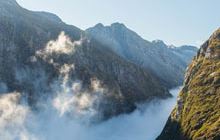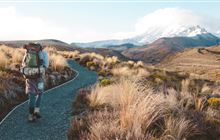Investigating alpine environments - Years 9-13
Introduction
This resource is designed to introduce secondary students to New Zealand’s extraordinary alpine environments, and support them to take action to help protect them.Learning outcomes:
Using this resource students can:
- carry out practical investigations and gather scientific data on at least one aspect of an alpine environment (ecology, geology, geography, sustainability)
- learn about some unique alpine plants and animals, and understand how they are connected within alpine ecosystems
- learn about the history and cultural heritage of Tongariro National Park
- investigate the interrelationships between people and alpine environments
- learn about threats to alpine environments and how people contribute to these
- identify how they can contribute to protecting alpine environments and take conservation action.
Download the resource
- Section 1 - Resource contents and introduction (PDF, 1,354K)
- Section 2 - Learning activities pre and post field trip (PDF, 341K)
- Section 3 - Year 11-13 NCEA assessment resources (PDF, 3,261K)
- Section 4 - Learning in Tongariro National Park (PDF, 1,559K)
- Section 5 - Understanding alpine environments (background info for teachers and senior secondary students) (PDF, 2,037K)
- Section 6 - Taking action to protect alpine environments (PDF, 900K)
- Section 7 - Student worksheets (PDF, 1,234K)
Plan your field trip to Tongariro National Park
There are four kits available. Each kit contains:
- 10 high- Vi's vests
- 1 GPS
- 1 set of transect location maps including instructions
- 1 tape measure
- 5 GSNZ Pocket Field Guides
- 1 copy of Which Native Forest Plant
- 1 copy of Which Native Tree
- 1 copy of Which New Zealand Insect
Book well in advance to ensure there is a kit available for your visit. Due to limited numbers, there is currently only one kit available per school.
Field trip guides
These study site guides can help you to plan fieldwork at sties in Tongariro National Park.
Site locations in Tongariro National Park (PDF, 1,559K)
There are 11 sites covered by the field trip guides:
- Study site 1 – Mangatepopo (PDF, 488K)
- Study site 2 – Whakapapanui Walk (PDF, 473K)
- Study site 3 – Round the Mountain (PDF, 489K)
- Study site 4 – Happy Valley (PDF, 476K)
- Study site 5 – Meads Wall (PDF, 495K)
- Study site 6 – Manawatu Ski Lodge (PDF, 490K)
- Study site 7 – NZAC Ski Lodge (PDF, 522K)
- Study site 8 – Mangawhero Forest Walk (PDF, 480K)
- Study site 9 – Ohakune Mountain Road (PDF, 481K)
- Study site 10 – Alpine Flush (PDF, 476K)
- Study site 11 – Tukino ski field turn-off (PDF, 463K)
Curriculum links
Level 7 - 8 Education for Sustainability
Knowledge and understanding
- Level 7: Investigate how to enhance and maintain biophysical systems and improve biodiversity
- Level 7: Investigate the aspects of sustainability in different contexts
- Level 8: Evaluate social, economic and technological measures that could be taken to sustain natural resources and improve biodiversity now and for the future
- Level 8: Analyse the impact of strategies and initiatives for a sustainable future
Attitudes and values
- Level 7: Examine the values and behaviours that will contribute to a sustainable future
- Level 8: Analyse the values of different groups of people, how these values are expressed in various practices, and the present and future consequences for sustainability
Actions
- Level 7: Plan, implement and evaluate personal action for a sustainable future
- Level 8: Analyse actions necessary for sustainability and plan, implement, critically evaluate personal action for a sustainable future
Level 5-8 Science
Participating and contributing
- Level 5 and 6: Develop an understanding of socio-scientific issues by gathering relevant scientific information in order to draw evidence-based conclusions and to take action where appropriate.
- Level 7 and 8: Use relevant information to develop a coherent understanding of socio-scientific issues that concern them, to identify possible responses at both personal and societal levels.
Living world: Life processes
- Level 5: Identify key structural features and functions involved in the life processes and the interdependence of living things.
- Level 6: Relate key structural features and functions to the life processes of plants, animals, and micro-organisms and investigate environmental factors that affect these processes
- Level 7: Explore the diverse ways in which animals and plants carry out the life processes Ecology Explore ecological distribution patterns and explain possible causes for these patterns
Living world: Ecology
- Level 6: Investigate the impact of natural events and human actions on a New Zealand ecosystem.
Planet Earth and Beyond: Earth systems
- Level 5: Investigate the composition, structure, and features of the geosphere, hydrosphere, and atmosphere.
- Level 6: Investigate the external and internal processes that shape and change the surface features of New Zealand
- Level 7: Develop an understanding of the causes of natural hazards and their interactions with human activity on Earth.
- Level 8: Develop an in-depth understanding of the interrelationship between human activities and the geosphere, hydrosphere, atmosphere, and biosphere over time.
Physical world: Using physics
- Level 5: Explore a technological or biological application of physics.
Investigating in science
- Level 6: Develop and carry out more complex investigations, including using models.
- Level 7: Develop and carry out investigations that extend their science knowledge, including developing their understanding of the relationship between investigations and scientific theories and models.
Physical world: Physical inquiry and physics concepts
- Level 6: Investigate trends and relationships in physical phenomena.
Communicating in science
- Level 7: Use accepted science knowledge, vocabulary, symbols, and conventions when evaluating accounts of the natural world and consider the wider implications of the methods of communication and/or representation employed.
Living world: Life processes, ecology, and evolution
- Level 8: Understand the relationship between organisms and their environment.
Level 5-8 Social Science
Social Studies
- Level 5: Understand how people's management of resources impacts on environmental and social sustainability
- Level 5: Understand how the ideas and actions of people in the past have had a significant impact on people's lives.
Geography
- Level 6: Understand that natural and cultural environments have particular characteristics and how environments are shaped by processes that create spatial patterns.
- Level 6: Understand how people interact with natural and cultural environments and that this interaction has consequences.
- Level 7: Understand how the processes that shape natural and cultural environments change over time
- Level 7: Understand how people's perceptions of and interactions with natural and cultural environments differ and have changed over time.
- Level 8: Understand how interacting processes shape natural and cultural environments, occur at different rates and on different scales, and create spatial variations
- Level 8: Understand how people's diverse values and perceptions influence the environmental, social and economic decisions and responses they make.


